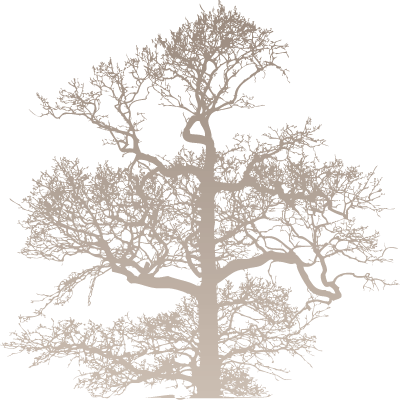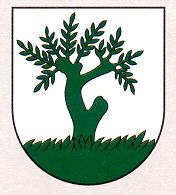
Translated by Tanya Koluncova. Edited by Ed Maul
Courtesy of John Jediny & Stanislav Doronenko
By David Kuchta
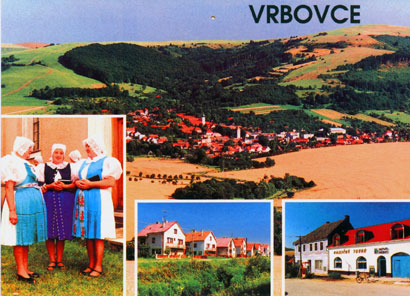
Translated by Slovakia University Graduate: Tanya Koluncova
Edited by: Ed Maul
This publication was published by the Municipal Hall of Vrbovce on the
occasion of the 600th Anniversary of the first written mention about Vrbovce.
Bud' pozdravena moja dedina "Be blest my town"
Willows are rustling silently in the moonlight,
The little winding brook is splashing over the stones.
These brooks are beautiful, when spring turns into summer,
The mornings when the spider spins its web in the dewy grass.
The white sky proudly embraces the green hills,
That majestically watch over the sprawling town.
These picturesque mountains
Vazeni citatelia! - "Dear readers!"
I am going to tell you something about our beloved village, which is dear to our hearts with its natural beauties, beautiful countryside and original architecture of the settlements around the village where people have lived for centuries. This is dedicated to the citizens of Vrbovce and natives living in Slovakia and abroad. This is a way to approach the historical development of the region in the last 600 years. In spite of all the difficulties our people had to overcome, the development has not stopped, and every century has affected the standard of living in our village. If we want to respect the present we should know the past.
Jan Hromadka, Mayor
Geographical Situation of Village
The village of Vrbovce is situated on the Slovak and Moravia border on the road that runs from Senica to Velka nad Velickou (Moravia). Vrbovce has a lot of small isolated settlements. Their names are Blanorovci, Chodurovce, Kamenec, Kopanky, Krslica, Matejov, Miechnovci, Stefanova, Valuchovci, Vapenik. They are situated on the surrounding hills of Zalotinska vrchovina, which belongs to the White Karpats mountains. The highest hills of Zalotinska vrochovina are Zalostina (621 m), Ostry Vrch (602m), Peckova (575m), Vesny vrch (564m) and Lipovy vrch (514m). The character of country is determined by a mosaic of the meadows, pastures and fields, beech and oak woods, and also swamps, which are along the Vrbovcianka river banks. A gentle warm mountain climate and a brown soil with hilly country make agriculture conditions for potato growing and livestock production. Vrbovce borders Moravia village Velka nad Velickou on the North, Slovak village Chvojnica on the West, Slovak village Sobotiste on the southwest and Slovak village Tura Luka on the southeast. Vrbovce also borders Brestovec on the very short frontier on the East.
HISTORY: The First Settlers
The oldest colonization of the suburb of Vrbovce links to the Old Castle, which is near Podbranc (below the Castle Branc). An archeological find shows that the castle was always inhabited since prehistoric times until the Middle Ages. The Old Castle had been a prehistoric center of the population of the surrounding county already in the Stone Age. (2900 - 1900 B.C.) There have been found the historical relics of the culture (urns used to hold cremated ashes) fields from the early and later bronze age. The other historical relics come from the Roman age (since 300 B.C. until the Christian era) and also from the Roman Empire (until 400 A.D.). In 6 - 9th century, Old Castle had probably belonged to Nigra princedom until the arrival of the Old Hungarians. The importance of Old Castle was diminished in era of beginning of Old Hungary in the 10th century, when the castle and surrounding county had become the part of North Hungary borderland (konfinium). The castle had been in an administration of king's military castles Hlohovec and Bana (at Piestany). Since the 12th and until the 13th century. The entire suburb had belonged to king's borderland county Holic, Komitat.
The first archeological proof of inhabitation in a locality of today's Vrbovce comes from this age. They are the oldest known evidence about an existence of the village of Vrbovce. Archeologist V. Jamrik has found the splinters from ceramic pots in 1970. He has dated them to the 12th - 13th century. In the 13th century the Hungarian kings stopped to manage the country over the commanders of king's military castles and they started to distribute the borderland to their soldiers. The kings made them to the heredity duties(services) and created new military - landowner aristocratical group. The new aristocrats then became the king's support in their foreign and domestic policy. The king's castle counties changed into aristocratical counties and Vrbovce fell within Nigra aristocratical county. In 1206 the Hungarian King Ondrej II from Arpad's generation, gave big property, later named how Plavecky Stvrtok, to Komes Alexander, and in 1217 he gave, until the time an uninhabited land, to the Komes Tomas. His successor King Belo IV (1235-1270) in beginning reign, gave the land of Sobotiste to Trencin aristocrat Baas, who was the son of Komes Bas. The Komes Baas built on the land, not far from Old Castle a new stone castle Branc in 1241. The castle Branc became a residence and administration center of large domain. The territory of future Vrbovce was a part of Branc estate. We learned it from old documents in which King Belo allowed to Komes Bas to sell this property to Magister Aba for 40 silver marks. Aba widened his property on the south side of his castle Korlatov Kamen. In 1297 Aba's son Komes Aba changed the inherited property of Sobotiste and stone castle Branc for a few villages of Magister Abrahama Rufusa. The king, Ondrej III, approved the change in 1300.
In the 14th century, Abraham Rufus had not been the owner of Branc for long, because the strongest feudal of West Slovakia, Matus Cak Trenciansky made him involuntarily exchange the castle for three villages on Povazie (the Valley of River Vah). King Karol I. Robert (1308-1342) annulled the illegal exchange in 1317, but Abraham Rufus could not use the castle, because Matus Cak Trenciansky gave it to his cousin Stefan Cech from Sterneberg, who used the castle until M.C. Treciansky=s death. After his death the castle Branc received a new owner- Czech King Jan Luxembursky, who returned Branc to the Hungarian crown in 1332. In the next decade the castle Branc and the entire territory belonged to the king. In this time there were established many new villages and many new inhabitants. Probably, the village Vrbovce was one of them. In the peaceful period, the value of all property increased with the prosperity of the village. In 1392 the King Zigmund (1387-1437) could use the territory but he had to borrow money from the Austrian Aristocrat Margaretato to pay for the land. The King had bought the property back but had it for a short time. In 1394 he gave it to his follower Stibor from Stiboric for services rendered. Latin deed of gift from the 16th of July 1394, which speaks about this transaction, is very interesting. There are named all the villages which belonged to the castle Branc since the oldest times in this document. Vrbowich (Vrbovce) is named too. It is the first written mention about Vrbovce. The original document is in the National Archive in Budapest, in the collection of the Middle Age documents with number D1 64736. Stibor's family owned the castle for two generations until 1434, when their family died out without a male descendant and all property was returned back to the king. The end of this era was connected with Hussite war. In 1428-1432 Hussite soldiers crossed the territory a few times, damaging the property of their enemy Stibor II from Stiboric and Beckov. There is a possibility that Vrbovce was damaged too, because the oldest documents about state taxes from the 15th century don't cite the town. Clearly, there was nothing to tax. Pankrac from Liptovsky Mikulas became a new holder of the castle Branc in 1437. From the beginning he was just an administrator, but later in 1462 he got the castle from the king Matej Korvin (1458-1490) into private ownership. But in a few years the situation changed, because in 1467 Branc was the kings military fort, which was led by captain Blazej Podmanicky. He made the Hungarian offensives to Moravia from this place. There were many soldiers from the army of Jan Jiskra among the soldiers in the castle Branc and surrounding territory. Blazej Podmanicky arranged a manufacturing plant of gunpowder in the valley of Vapenik. Later, this place was named Prachovna. The factory was led by Italian Inocent Vergulini from Verona and vanished in an explosion. The 16th Century Toll station is the first information mentioned about the size of Vrbovce.
The castle Branc together with Vrbovce were given back to the Pankrac family. Baron Frantisek Nari (Nyary) inherited it from his mother Eufronzina Pongrac. The King Ferdinand I (1526-1564) approved the using of the castle in 1547. Vrbovce is remarked as Warbocz in deed of gift. Frantisek Nari supported the protestant reformation and contributed to the evangelistic school in Zenica. He allowed the ana-Baptists to stay on his property in Sobotiste. They were handy artisans and they were running from Germany over Moravia to Slovakia. Frantisek Nari died in 1551 and his nephew Vavrine Nari inherited his entire property. The castle Branc stayed in the hands of Nari family, but later it received more co-owners. By distribution of the property among sons and married daughter, the Pongrac, Appony and Amadeo families became the owners. During the reign of King Maximilian (1564-1578) the number of inhabitants increased in the old villages; many new villages were established, because a lot of refugees came from the south, who were running from the Turks, and from Moravia who were running from the counter-reformation. All these circumstances supported the founding of a toll station in boundary passage (transit) between Hungary and Czech. The historians assume that the toll station was established in the 16th century. It proves the time limit of numismatic findings of old coins, which don't go back later than 1547. From this time the first information about the village is known. There is recorded that the state tax in Vrbovce was collected from 25 ports, in Tax portal list of Nigra county from 1576.
The word port comes from Latin and it means one farm with a few farmhouses and dwelling houses for one or more families with a common yard and an entrance gate. In 1590 the inhabitants of Vrbovce built the church in renaissance style and consecrated it to St. Alzbeta (Elizabeth). It is one boat building with a polygonal presbytery and a tower, which is clenched by an arch with the lurrettes and from outside strengthened with supporters. The inhabitants arranged a new parish and a parish school. Because the people and the owner Nari sympathized with a religious reformation, the new rectory had mostly a protestant character. In the beginning of the 17th century, when the Vienna peace from 1606 finished Bojcak classes and religion anti-Hapsburg revolt brought freedom of a religious election, the Lutheran church was established in Vrbovce.
THE 17THh CENTURY: Revolts, Wars, Rebellions and Reconversion
The archival documents from the 17th century allow us to have a deeper look into the economic situation and social distribution in Vrbovce. There are the oldest land registers (urbans) of Branc estate 1617,1638,1682 in the State regional archive in Nigra. The "urbans" are a specific kind of economic-legal documents from feudalism. The landlords used them as for evidence for records of their subjugated people, their properties, work duties and taxes. According to these documents there were 59 subject feudal farmsteads divided among 20 farmers, which worked on the quarter of one farmstead. The land of two farmsteads was empty, because users died. There was one dependent settlement in the village. The subject people were parted by the size of their property. The peasants had a house, a garden and the fields, the tenants had just the house and the garden. The peasants paid one gold coin, the "half" peasants paid 50 denars and the rest 25 denars per year. They made payments three times a year, on April the 24th (St. George), on September 30th (St. Michael) and on Christmas. They also had to supply the kitchen in the castle Branc with food. These Anature@ supplies were called Adanky@ From poultry the peasants gave two capons, the tenants one capon on Christmas and on Pentecost, the peasants were giving 15 eggs and the tenants 5 eggs per year. In the time of Lent the independent farmers gave two holbas (1 holbas 0833L) of pease, millet, hemp seeds and butter. The peasants gave from everything one holba. From grains the peasants were giving two mericase (1 merica = 53,33L) of wheat and one merica of barley and oat, the tenants half. All people from the village had to give money, 6 gold coins to feed a pig and 3 gold coins to feed a calf for the castle. The entire village paid fee a 150 of gold coins for land. There were some craftsmen and tradesmen in the village too and they had two millers who lived in two mills. They paid the landlords 14 denars per year, they had to feed one pig for them and to do carpenter work in the castle. The butcher gave 40 pounds of tallow, the tavern-keeper had to sell in his inn 170 casks of landlord's wine. Two malt houses were used for production of malt for the cooking of beer. One malt house belonged to the landlord and the other one, which paid 100 gold coins per year in tax, belonged to the village. The surrounding oak woods were rich for acorns, which were used by landlords for the feeding of pigs. The peasants were allowed to take wood just from the certain part of the forest, the rest was forbidden. They couldn't hunt or fish in the river Vesnik, it was allowed just for the landlords. In the locality of Vrbovce were two meadows. One belonged to the landlord family of Tardiovci and the second to the family of Amadeovci. The second one was rented by Venco Vrba for 6 mericas of oat per year.
The names of the peasants are not listed in this time. Besides the name Venco Vrba we can learn about surnames how Babykovsky, Kasovy, Mlynar and Azjic from 1617, or Benca, Dubik, Fillus, Homola, Kovalcik, Polasek and Tesar from 1682. More we can learn about village's boundary names, which are mentioned in the description of the village boards: the creeks: Vratina, Vesnik, the springs: Zenicko, Studnicka, water: Soli, Ravoir, Cervene blato (red mud), hills: Lipove or Vesela hora, roads: Simani, Klasko or names which meanings are not determined like: Kocurove kuty, Koninska Hlava, Haluznik, Dluhopole, Vapenka, Opatova, Pusta Myjava, Kojto, Dislak. The situation recorded in the "urban" was interrupted by the thirty years war (1619-1648). In the time of very bad kuruck - laban war both sides, classes mutineers and Czar's army devastated the locality of Vrbovce and people. The Polish kozaks burnt down the village Myjava in November 1621. Two years later the army of Gabriel Bethlen went through the village and people had to hide in the castle Branc. In this very difficult war time Vrbovce noted some developing. A local autonomy had been fortified. It proves a fact, that it became a municipal; seal with a plowshare had been used for the first time. People of this Lutheran country were not afraid just of the army and soldiers, but of the new religious situation too. There was a tendency of re-conversion and to return the churches to Catholics. In 1672 a Bishop Barson was sent by the king Leopold I (1655-1705) for the purpose of reconversion. The act of reconversion was very bloody. In Tura Luka many people were killed. They were defending their church. The Lutheran priest Michal Lani from Vrbovce was coerced to leave the village and go to Germany. But the Evangelicals never gave up their religion. After the Thokoly revolt (1678-1687)the Lutheran priest of Vrbovce was allowed to come back. After the revolts, when Hungarian offices were investigating the peasants that were involved in the rebellions, they checked to who the peasants belong. They found out a composition of the "komesors"- the owners of the castle Branc. Except the Naria's and Amadeo's families there were 16 other owners (families: Blaskovic, Caunera, Cepetic, Esterhazy, Kerekes, Horvath, Najten, Mednansky, Nadmihaj, Nadlesenej, Bazgov, Sandor, Trstiansky, Vandelin, Vicajov, Zongora and an exchequer, who took a part of death owners.
The king considered that a big number of the castle's owners caused the disobedience of peasants. For this purpose the king gave the castle Ostrihom to Archbishop Juraj Slepciansky in 1685. It provoked a reformation effect. The Evangelic churches from the villages of Branc and Cachtice domains connected and established Branc-Cachtice ev. seniorate - deaney. The villages that belonged: Brezova, Bzince, Krajny, Myjava, Prietra, Tura Luka and Vrbovce. The seniorate had on their territory great power because the Catholic inspectors didn't have the courage to come to this county. In 1698 a big change happened. The Catholic landlord, Adam Kristof Erdody, got the castle Branc. He organized a very strong reconversion and put the Evangelic priests in jail. In 1701, the villages of seniorate asked the king for religious freedom. They were encouraged by the anti-Hapsburg revolt of Frantisek II Rakoczi. His army occupied West Slovakia and in 1704 came to Vrbovce, where he stayed on Ostry hill and from where the army attacked Moravia. The stay of the army allowed the evangelists to reopen their churches. From 1712 the name of the priest is known too, it was Matej Silvaj.
THE 18TH CENTURY - Vrbovce in 1752
According to the tax documents from 1715 and 1720, the village Vrbovce had 65 households. 36 belonged to the peasants, 29 to the tenants and 3 of them were mills. Two surnames appeared in the list of the owners of Branc domain, Kalis and Revaj. In 1724, the evangelist church in Vrbovce got a new priest, Juraj Ambrosius from Dolny Kubin. In 1732 the evangelists asked the king to remove "artikular" center from Catholic Straz to Prietrz or Vrbovce. The king agreed and in 1733 "the artikular" center was established in Prietrz, where the new church, school and rectory should have been built. The "administration" in Nitra county took this opportunity and returned all "non-articular" Evangelic churches on it's territory to Catholics. Among the churches there was the church in Vrbovce and the old church in Prietrz. The evangelists had no church of their own and a new one couldn't be built until 1781. So they set up a temporary house of prayer. The old church of St. Elizabeth was taken into permanent use by Catholics on 29th of January, 1734. We can learn interesting information about the life in Vrbovce in the middle of the 18th century from the tax documents of the village from 1752. There lived 782 families in the village, 421 families lived in the village and 311 families in the surrounding hills. According social classification the tax list is divided into 293 peasant families (137 in the village and 156 in the surrounding hills), 198 tenant families (43 in the village, and 155 out) and 241 "below" tenant families. In that number are included 73 families of which members were craftsmen. They worked on 30 farms. The size of the farms together was 1889,5 "bratislavska merica". The fields, which were rather rocky, were situated in the hills and in the valleys. They were plowed by the tow horse team and they achieved double yield.
The peasants stored reaped grain into sheafs and crosses and they were able to obtain from three 16 feet high crosses one bratislavska merica of corn. They had to deliver 1/10 part from the fields to the lord's family. The peasants grew cabbage too. The cabbage field had 43,770 heads of cabbage. Some of the serfs had the gardens with fruit trees, but fruit was just for their own consumption. Every year they got approximately 260 loads of straw. They raised 346 weight - lifting animals, (107 horses and 239 oxen), 337 milk cows, 25 farrow cows, 193 one year old oxen, 1,336 sheep and goats, 193 pigs and 14 beehives. The nearest markets were in Sobotiste, Senica and Myjava. There were 9 mills in the village boundary. The mills belonged to 17 families: Bohus, Husar, Ghodul, Janovic, Josefovic, Karpistak, Kotulac, Marecek, Martinkovic, Michna, Mikulasek, Minaricek, Minarovic, Turan, Petrovic, Uher, Valusek. Each mill had a piece of field which cost them every year 71 golden coins, which they paid to the landlord and 21 golden coins and 40 denars, which they paid to the county. Two distilleries, which belonged to those of the Jewish faith, Abrahams and Filip, paid 70 golden coins per year. Tax list records seventeen other handcrafts, as the bag making, sieve making, the butcher and the tobacconist. Clothes and shoes were made by five tailors, two furriers and thirteen shoemakers. There was one sawyer, two cabinet makers, two coopers, one wheeler, five smiths, one trader with metal goods and four traders with grocery stores.
The tax list from 1752 contains the surnames of all families, which were living in the village at this time, page 13 in the book shows:
Abraham, Adamek, Adamicak, Adamov, Andrls, Bacany, Bacik, Bajza, Bakos, Balas, Bartos, Bednar, Bernasek, Blanar, Blaskuv, Blazej, Blazek, Bobcik, Bobsik, Bohus, Brindza, Briza, Bucek, Cech, Cernak, Cernin, Cerveny, Chmula, Chodnik, Chodor, Chodurik, Chodurny, Chojil, Cihak, Cizmar, Curikaj, Curnbal, Dinderak, Dobovy, Dudik, Durcak, Durena, Elias, Fak, Filus, Folt, Freska, Frlik, Fusek, Fuxa, Gabor, Gabricek, Gajdosik, Gala, Galas, Galik, Gazicka, Gocna, Gornbar, Grabek, Gusi, Guska, Halencik, Hamrsky, Hanacek, Hanik, Havlicek, Hladena, Hlozek, Hlusnicek, Hnilicka, Hogyasz, Holy, Homola, Hores, Hornacek, Hornak,Horvath, Hrobar, Hrornko, Hrubes, Hruby, Hujik, Humek, Hurban, Husar, Jagos, Jakub, Jankuv, Janiga, Janovic, Janovik, Jacurak, Jasa, Jediny, Josefovic, Jozefov, Jozifek, Jurasek, Jurcak, Jurena, Jurenka, Jurinec, Juris, Jurica, Juricha, Kadlicek, Kalcak, Kalka, Karas, Karpistak, Kassak, Klanduch, Klusak, Knihar, Knitlich, Kojs, Kokes, Kolaja, Kolar, Kolarcik, Koldrik, Konecoy, Korytar, Kosik, Kostrhul, Kotulac, Kovac, Kovalcik, Kozek, Kozik, Krbica, Krc, Krciva, Krcuv, Kresica, Krizan, Krocirek, Kuba, Kubenka, Kubicek, Kublca, Kucharek, Kudilcek, Kulka, Kuncak, Kupak, Kuricky, Kursky, Kuvicky, Liska, Löbl, Lulis, Lulisky, Lupkacek, Macala, Macek, Martinkovy, Martinus, Martincak, Masar, Matula, Matuska, Melicharek, Miavcuv, Michalica, Micka, Miechna, Mikolcik, Mikulasek, Misik, Milo, Mitascek, Mitak, Mistecky, Mlynaricek, Mlynaärovic, Moravcin, Mucha, Myjavec, Nalca, Nalci, Neborka, Nemcov, Neurocny, Neznany, Obrhlik, Olencik, Omasta, Ondris, Oslej, Palka, Panik, Patinak, Pavela, Pavelka, Pavlasek, Pavlav, Petrak, Petrovik, Petruch, Petrzelka, Piacek, Pihodnik, Plesa, Poliak, Pomartin, Pospisil, Povalac, Pribis, Pruskac, Redeca, Roncek, Rosik, Rustak, Safrane, Samek, Saricek, Sedlak, Sifel, Sindelar, Siska, Skepelik, Skoda, Skodak, Skok, Skrha, Sladek, Slepecka, Slezak, Sloch, Scasny, Scerba, Sok, Sokol, Sramo, Strycek, Stasny, Stefanuv, Stefcek, Stefek, Sterba, Stresnak, Sukan, Sukavy, Sukup, Sulik, Sustek, Svetlik, Tehlar, Toman, Tomecek, Trunecek, Turan, Turba, Tvrdy, Uher, Vaculka, Valach, Valasek, Valcharuv, Valach, Valek, Valent, Valihora, Valusek, Vanek, Vasek, Vasicek, Vavro, Vitek, Vnuk, Vojtech, Vrabel, Vrna, Zajic, Zajicek, Zakus, Zamecnik, Zelenak, Zigmund, Zima, Zloch, Zurek.
The names which were mentioned which I found in the list:
Elias, Filus, Hornak, Jozifek, Melicharek, Sukup, Stefek, Valuch, Vana, Vitek and Vojtech. Most of the names are Moravian and Slovak, but you can find Polish, German, Hungarian, even Italian and Jewish. The tax list was made for a purpose, to find out how much the village should pay for tax. In 1750-51 (Nov 1, 1750 - Oct. 31,1751) the village paid state tax 1346,27 golden coins and county tax 396,52 golden coins. In 1751-1752 it was 1856,15 golden coins for state and 343,45 golden coins for the county. In the following years positive development in the village was interrupted by a big fire. Part of the village and the church were burnt down. The Catholics repaired the church after the fire. They bought a new baroque baptistry and an organ box, which was in late - baroque style. The evangelists improved their position after the Declaration of Religious Tolerance in 1781. After the tolerance patent was issued, they concentrated their efforts to build new church in 1784, but it had to be built without a tower. In Vrbovce there lived Catholics, Evangelists and Jews.
The First Census of People in Austria-Hungarian Monarchy
The first census started in 1784. The results for the first time showed a good amount of people living in Vrbovce. After the end of census in 1787, 4,493 people lived there in 813 families, which lived in 685 houses. In the time of census 4,435 people were present, 1 foreigner, 59 people were out of the village. There were 2,261 adult men, 2,032 women and 905 children. From the men 872 were married and 1,389 single. 785 children were younger than 12 years and 120 children younger than 18 years. They had to have a school, but there was no mention about it, only 50 years later. There were 2 priests, 9 yeomen, 548 peasants and the members of their families, 590 tenants, 2 soldiers and 169 others, like the servants or the craftsmen in the village, according to the social distribution. The village was included among small villages with a few landlords, Horecky, Amade, Jesenak. Approximately the same situation was in the village in the beginning of the 19th century, except they got one more landlord Zay from Bucany.
The 19TH Century: The Town Vrbovce
In 1808 Vrbovce was still a village but two years later it became a town. Vrbovce received from the king Ferdinand I a market privilege from July 16, 1810, which authorized people to arrange a local food market on Mondays and 6 times per year a craft and trade market, and a cattle market. The markets were on Mondays, before religious holidays, for example, holiday of St. Paul or All Saints Day. The markets had a propitious effect for the development of the village. The introduction of a new coat of arms was a very important event for the village too. The emblem was with a illustration of willow tree with roses on the top and was placed on the town seal together with the Hungarian sign "Seal of Town Vrbovce 1810". The tax documents from 1828, which are filed in the State archive in Nitra, offer details on the conditions in the young town. Jan Skodacek was a mayor of the town, he had 16 members of the town council and one public notary. They all together directed joint interests of 4,854 inhabitants living in 819 families and 782 houses. There were 4,489 evangelists, 285 Jews and 110 Catholics. According to the social position there were 189 peasants and 578 tenants, 38 "below" tenants, 3 servants and 46 craftsmen. They all together cultivated fields, 1889 bratislavska mericas. The fields are barren, winter wheat and barley are obtained in the same amount how it was seeded. The fruit gardens weren't there anymore. They had 20 bratsklavska mericas of public wood and some public pasture. They raised 194 weight - lifting animals (from this number 67 horses and 127 oxen), 340 beef cattle (292 milk cows, 48 two years old oxen), 639 sheep and 2 oaths and just 2 pigs. According their peasant duty, they had to work off 1,429 days of "handy job" on the land of their landlords. But they got opportunity to pay out for themselves by money. Instead of work for the landlord, they paid him 421,12 golden coins per year and in time they worked on their fields and in the workshops. 36 masters with 11 helpers worked in 9 trades (crafts). Bag making was the most popular. 24 people worked in this trade. They traveled through the county and sold the bags and sieves. There were 10 millers, 4 smiths, 2 fur makers, 1 carpenter, 1 locksmith and 1 wheeler.
These families lived in Vrbovce in this time:
Adamech, Aitner, Altmann, Bacany, Bacik, Bajza, Bajzik, Bakos, Basnak, Beblavy, Bednar, Bednarik, Behulik, Belka, Bettak, Biela, Blazek, Bobcik, Bohus, Bozicek, Brindza, Brna, Bucek, Cerny, Chalupa, Chladek, Chlebik, Chmula, Chrenka, Chrmek, Damisak, Durisa, Dvorak, Elias, Ezler, Feier, Feue, Filka, Filus, Filusek, Findler, Fisata, Fusek, Gabor, Gala, Gazik, Hahn, Haim, Hajnik, Halabrin, Halencik, Hlasnik, Hlasny, Hodonin, Holes, Holubek, Homola, Horas, Horcik, Hores, Hornak, Hrubes, Hubicek, Hubinan, Husak, Husar, Hyza, Ichzer, Jacinka, Jagos, Jagosik, Jakub, Jandek, Janega, Janik, Janovich, Jatinka, Jediny, Jozefak, Jozefek, Jurenka, Juricza, Juriga, Jurina, Jurisak, Kalincak, Kalm, Karbiscak, Kasa, Kascak, Kavicky, Kesztler, Klvac, Kohn, Kolaja, Kolarik, Königsberg, Korsik, Kortulac, Kovalcik, Kovarcik, Kozar, Krarnar, Krbica, Krc, Krcek, Krizan, Kuba, Kuchar, Kuchta, Kudelka, Kudlena, Kühn, Kühner, Kupcak, Kurecka, Kutalek, Lalis, Lewenrosen, Licka, Lona, Lula, Lulicky, Lulis, Macek, Madarik, Majtuch, Malarik, Malovych, Maly, Marcisk, Mardek, Marecek, Marek, Marek, Masar, Matala, Matula, Matulik, Matusek, Melicharek, Melicher, Mihal, Mihalovich, Mikula, Mikulcak, Minaricek, Misik, Misik-Gajdos, Mitacek, Mitder, Mittagh, Mlynaricek, Mucha, Müller, Myjavec, Neurocny, Neznamy, Obrtlik, Ochsenberger, Omasta, Ondris, Ondrisek, Opalcak, Osle, Ostrasil, Pagac, Palka, Palla, Paluch, Pancurak, Paska, Pastorek, Paulusek, Pavela, Pavelka, Pavik, Pechurny, Petrus, Petrusin, Planansky, Plesa, Podmajersky, Polacek, Polak, Povalac, Privratsky, Prihoda, Pudelka, Rebeka, Reich, Reichsfeld, Ruzicka, Rybnikar, Salamon, Scasny, Scher, Schiffel, Schmieder, Schön, Schuler, Schwer, Sebo, Siska, Skalka, Skodacek, Skok, Skopalik, Skopcihak, Skup, Sladecek, Sladek, Sobotta, Sok, Sokol, Sonnenschein, Sotina, Stefecek, Stefek, Steffek, Stein, Straka, Stresnak, Sukup, Sulc, Susta, Sustik, Svec, Turba, Tvrdy, Vacek, Valach, Valasek, Valek, Valihora, Valuch, Valuch, Vanek, Varusa, Vasicek, Vavra, Vitek, Vittek, Vnuk, Vojtuscak, Vrablic, Vrana, Vrba, Winkhauer, Winter, Wolf, Zabcak, Zamecnik, Zigmund, Zima, Zloch, Zrinyi, Zurek.
Bohus, Elias, Filus, Hornak, Jozefek, Kavicky, Melicharek, Ruzicka, Sukup, Stefek, Valuch, Vittek. We can find here some new German names, which were brought by the Jews. They made business here and they became probably very rich, because in 1830 they built their own synagogue and new Jewish cemetery. The oldest obelisks are from 1837. In 1831 a choleric epidemic raged in Slovakia. 111 were ill and 26 died in Vrbovce, but later the amount of people increased and in 1836 it was 5,207 inhabitants. Maybe from thanks for the protection before the epidemic a folk statue of Christ Crucified from unknown artist was added in the Catholic church. In 1833 Mr. Brezany made a very good copy of Sistine Madonna. The evangelists built a new church tower during 1839-1841. The list of owners of Branc domain was changed too. It happened in the forties of the 19th century, after dying out of Amadea family. Their part Schmertzing family inherited, so at the end of feudalism Branc domain together with Vrbovce belonged to count Naria, Barons Jesenak and Horecky, landlords, Konrad, Pettko, Schmertzing, Tombo, Vietoris, Smrtic and Zarnovicky.
Hillside View of Vrbovce
Courtesy of John Jediny

The house of John Jediny (Above) and his Grandmother's home (Below) photographed in 1980. His home has since been demolished. The year 1861 was caved in the center beam of his Father's house. It only had one room, and the roof was slate. John was born in Vrbovce in 1934 and came to the United States in 1947.
Courtesy of John Jediny
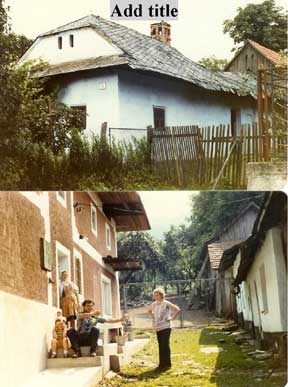
John Jediny's relatives and neighbors dressed in tradtional local costumes.
Courtesy of John Jediny
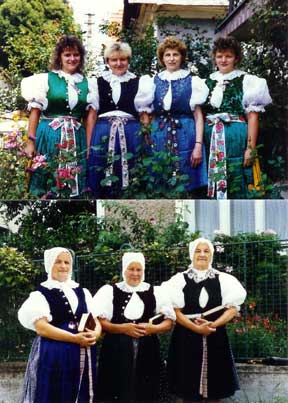
Catholic Church
Photographed by, Stanislav Doronenko
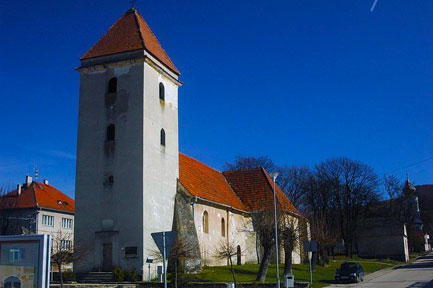
Lutheran Church
Photographed by, Stanislav Doronenko
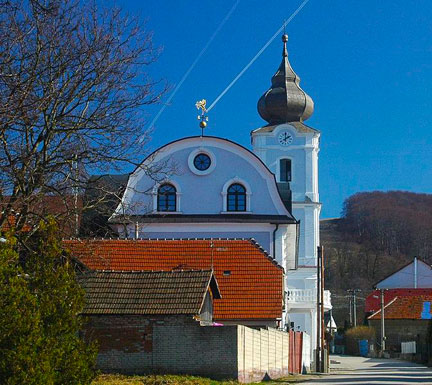
By David Kuchta
My maternal Grandfather was George Zloch. He emigrated from Austria/Hungry or what is now Slovakia. He and his family lived in the area of Vrbovce and Myjava. I have traced back this Zloch (Americanized to Zlock) line to the late 1700's. At this point, I thought I couldn't go back any farther, but a new found friend sent me an article that had appeared in one of the bulletins from the town of Vrbovce. I found this to be very interesting.
Of course, at this point, I can't claim that this Zloch was part of my ancestral heritage, but from all reports it just might be possible. This conclusion is an assumption on my behalf but, it may be correct. In the summer of 1582, the year didn't begin very well for people from the Village of Vrbovce. The lord from Straznica, whose name was Jan Junior from Zerotin , gathered about 1,500 men from his district and marched towards the Village of Vrbovce. They were armed with muskets, scythes and flails. After coming under the mountains (Maly (small) Carpathians), they followed through the district until they reached a brook near a Long meadow. From there they crossed the woods and around noon they were as far as the first Vrbovce hamlet. The reason for all this commotion was a suspicion that people from Vrbovce cleared the woods that belonged to John Junior from Zerotin and used the land to grow crops and graze their cows, goats and sheep. Of course the Lord from Straznica wanted to punish these local people by destroying their crops. His men cut down young trees, tied them together and pulled these tools of destruction all through the wheat fields as far as the hill near the Vrbovce village. Having destroyed everything, the invaders moved towards Velka. Realizing what had happened, the people from Vrbovce, including their pastor started chasing the invaders. They had no guns at that moment and had to stay at a distance, far enough not to be shot at when the Lord of Straznica ordered his men to shoot. In the meantime, the men were cursing and hollering at each other until armed men from the Village of Vrbovce arrived and then the shooting started. Because of this altercation there were causalities on both sides.
A week later a committee from Branc Castle came to figure out the damage and solve the border dispute. Committee members wanted to know where the real boarder was and so they took a ranger from the Vrbovce Woods whose surname was Zloch. His family had this ranger job for over three generations. On the wagon, together with Old Zloch, who was supposedly 146 years old, was his great, great grandson, 10 year old Stefan and walking with the wagon was his grandfather, who was 85 years old. (Authors notes: Old Zloch was probably over a hundred years old, but the age listed of 146 seems to be a little high.) After crossing the damaged fields and meadows they entered the woods and there they stopped. Here Old Man Zloch was showing the committee members where they used to graze their animals and nobody was bothering anything. The Committee having believed him decided to perform a "Partus" right in that area. (Author's note: I think a "Partus" was a legal acceptance of owning land as far as the eye can see but this is only a guess on my behalf.) Lifting young Stefan on their shoulders he had the young boy him look round while Old Zloch was telling him: Dear son, here you graze freely and don't be afraid of anyone, this is our land and if some Moravian tries to capture you, defend yourself and if necessary, shoot him in the nose. After saying this, Stefan’s grandfather slapped him on his back several times not to forget this important historic moment and location.
In those days a " Partus" was performed instead of placing boarder mark stones. Later in life, Stefan was mentioned in many documents where he had testified in boarder disputes and his testimony was always ended by a statement: "This is our land what I got as a "Partus," when I was a very young boy". At the present time there are about five clans of Zlochs living in that area of Slovakia. The time frame of this article was about 450 years ago so I would like to think that "Old Man Zloch," was the Matriarch of all future Zlock clans now living in Slovakia or for that matter, the United States. I also am going to assume that the area outside of Vrbovce that is mentioned is the Hamlet of Zlochovci. This is a valley with hills similar to the Mahoning Valley in my area of Pennsylvania. I visited this area two years ago during my trip to Slovakia and It surely is a beautiful area.
